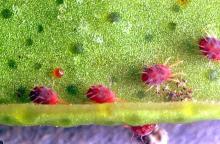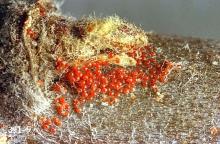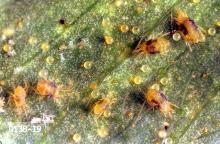Includes
European red mite (Panonychus ulmi)
Twospotted spider mite (Tetranychus urticae)
See:
Pest description and crop damage Several species of mites can cause damage in ornamental cherry. Principal mite pests of cherries include the European red mite and the twospotted spider mite. Appearance of these mites varies with the species, although all are 0.02 inch or smaller. Female European red mites are round with red bodies; males are yellowish-red. Twospotted mites are oval and yellowish-brown or green with distinctive black spots on the body. Mites damage fruit indirectly by feeding on leaves, which causes stippling, bronzing, and possibly leaf drop. The reduction in photosynthesis causes loss of vigor and yield.
Biology and life history Red mite overwinters as eggs on smaller branches and fruit spurs. They hatch at pink stage and commence feeding. There are six to seven generations per year.
Management-chemical control
Horticultural oils are most effective against European red mite, and during the egg stage of the mite life cycle.




